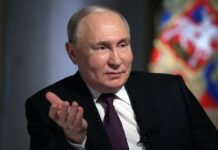Washington, D.C. — October 10, 2025
In a major escalation of the Ukraine-Russia conflict, the Trump administration has authorized U.S. intelligence and Pentagon assistance to support Ukrainian long-range missile strikes targeting Russian energy infrastructure. This decision marks the first American greenlight for operations striking deep into Moscow’s heartland, a move analysts say could reshape the strategic balance in the war.
The announcement coincides with urgent discussions among NATO allies regarding the potential provision of Tomahawk cruise missiles, capable of striking targets up to 1,500 miles away. These strikes, if executed, could cripple Russia’s energy networks, disrupt supply lines, and undermine war production, but also risk intensifying Vladimir Putin’s military response.
Trump and NATO Push: Coordinated Pressure on Moscow
This authorization builds on the September 16 PURL approval, which allocated up to $1 billion in arms and munitions for Ukraine via NATO channels. Officials confirmed that the new decision enhances intelligence sharing, targeting support, and potential missile deliveries.
President Trump, speaking with Finland’s Prime Minister, emphasized the need for NATO to “step up pressure on the Kremlin” to force a decisive resolution. U.S. defense officials noted that Kyiv’s military had prepared specialized strike teams capable of leveraging these systems against critical Russian energy nodes, from power plants to oil distribution centers.
Russian Response: Escalation Warnings
Russian President Vladimir Putin condemned the U.S.-backed initiative, calling it a “qualitatively new stage of escalation” in the conflict. Kremlin spokespeople warned that these strikes could provoke retaliatory attacks, including potential targeting of Ukrainian cities and extended strikes on NATO-adjacent assets.
Experts warn that while long-range strikes could seriously degrade Russia’s war economy, they carry substantial geopolitical risks, including a potential broader confrontation with NATO.
Strategic Implications: A War Economy in the Crosshairs
Analysts suggest the move signals a shift in Western strategy, from defensive aid to offensive support designed to hit Moscow’s strategic infrastructure. Key potential outcomes include:
Disruption of Russian energy exports, pressuring the Kremlin financially.
Enhanced leverage for Ukraine in ongoing negotiations over contested territories.
Intensified military and cyber retaliation risks, both in Ukraine and against NATO partners.
The approval is also seen as a boost to U.S. defense exports, as the Pentagon and U.S. defense contractors stand to supply advanced missiles, targeting systems, and training programs.
Public and Political Reactions
Washington insiders report mixed reactions on Capitol Hill. Some lawmakers praise the move as a decisive step supporting Ukraine, while others warn of a wider war and potential escalation beyond Europe.
Meanwhile, in Kyiv, Ukrainian officials welcomed the news as a “game-changer,” noting that the enhanced strike capability against Russia’s energy infrastructure could force Moscow to rethink its operational priorities.
Key Takeaway:
The U.S.-backed authorization of long-range missile strikes and Tomahawk deliveries represents a pivotal moment in the Ukraine war. While it offers Kyiv an unprecedented strategic advantage, it also raises the stakes for NATO, Moscow, and the global security order. The coming weeks will reveal whether this bold move accelerates a Ukrainian advantage or provokes a deeper escalation.
















